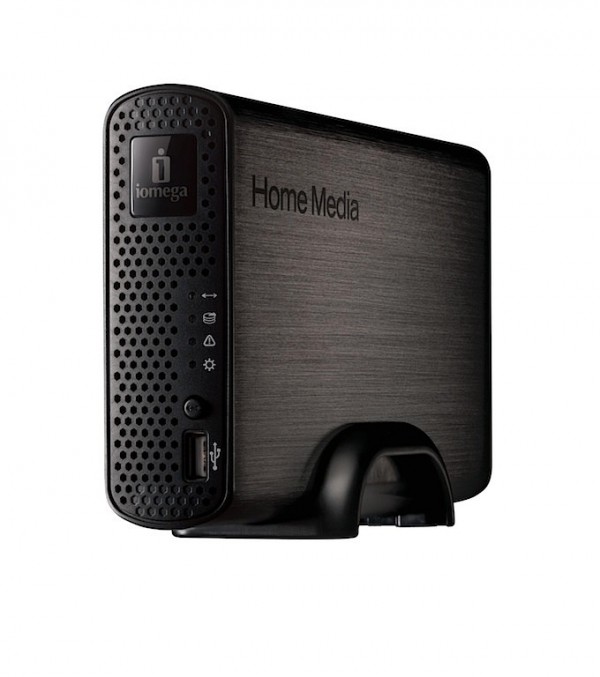
At the rate new network-attached storage devices, or NAS, are being released in the market, it would come as no surprise if consumers are not able to easily determine which one offers the best bang for the buck. Most recent offerings would seem like minor departures from previous versions, something that is never popular with the consumers. Iomega seemingly reexamined the core of the buying logic of customers, and found that the best way to distinguish its products from the rest of the pack is through ease of use. This philosophy gave birth to the Home Media Network Hard Drive, which combines accepted NAS functionalities with the proven track record of storage expert EMC, whose software it employs. These two concepts together produced a NAS device that boasts user-friendly shared storage and media streaming for home networks.
The drive is available in offerings of 500GB and 1TB. The physical layout of the Home Media Network Drive is very similar to those found in the usual NAS appliance. At the rear portion of the hardware is found a lone Gigabit Ethernet port to connect to a router, and a USB port to receive a conventional external storage gadget or hard drive for purposes of copying its contents onto the network. The external hard drive may also serve as an additional network storage device when attached to the unit. The USB port may be also used to plug in a printer, a feature that makes the unit a virtual print server. For home networks without printer sharing functionalities, this is decidedly a plus. The presence of a second USB port, however, will be sorely missed if the user looks to have a print server function and supplementary drive at the same time. A power jack completes the port lineup of the rear panel. The corresponding adapter is oval-shaped and poorly-oriented for plugging into a two-socket outlet if one of the two sockets is also occupied by another power brick.
The aesthetics component of the Home Media Network Drive is very impressive. The majority of the exterior sports a brushed metal finish in a seductive dark color, with the front covered with a plastic mesh panel. On top of the case near the rear portion are found a couple of LED indicator strips, one lighting up in white when switched on and to denote activity in the drive. The other indicator lights up in different colors depending on the remaining storage capacity of the drive. Iomega thoughtfully added sliding dimmer soft controls for the power LED, to make it more discrete if the user so desires.
As advertised, installation is fairly easy. The NAS device is simply attached to a network router’s Ethernet port via a cable which comes with the unit, plugged to an AC outlet, and switched on. At this point an external drive or printer may be attached via USB to the unit. The device is then configured by installing the attending software on a networked PC.
Once the unit is assigned an IP address, it may be accessed through Windows Explorer in any of the network’s client computers. The drive similarly showed up with ease on wireless clients without the need to pre-install any software in those platforms.
Once installed, the management software of the Iomega Home Media will appear in the host PC as a drives V to Z in Windows Explorer. The letters stand for virtual drives for backups, movies, music, and photos, with the last one for a shared folder capable of being accessed from any point in the network. These drives will show as regular folders when viewed from the unit itself. The five virtual drives run using the NAS device’s storage capacity, sharing either a 500GB or 1TB drive depending on the model. The software interface features controls for adding or deleting folders, as well as provide secured access to any of the same. A folder can also be set as a server for DLNA or iTunes. With DLNA enabled, users are able to stream media files from the folder to such devices as a client TV that features DLNA support, as well as game consoles like the Xbox 360 or the PS3. Video streaming over an 802.11g wireless standard is also a breeze.
A trio of separate tabs subdivides the Home Storage Manager interface. The controls mentioned above are found in the Folders tab, while storage capacity status and events are monitored by the Home tab which keeps logs of its activities. The final tab is a System tab for returning the drive to its factory settings, switching between manual and auto mode for IP addresses, setting up the drive clock and calendar, plus the usual utility for creating user accounts and establishing passwords. The entire interface exudes simplicity with its straightforward approach and omission of highly technical terminologies. The software’s user-friendliness theme is further enhanced by the drive being contained under the Programs menu in Windows Explorer, which is a nice alternative to inputting the drive’s IP address into an internet browser. While both methods are possible with the software, the first one caters to network beginners rather nicely.
A means to do backups comes in the form of Retrospect Express HD 2.5, developed by EMC. This software lets users choose the content to be backed up to the unit individually, by file type, or even by folder or drive. Scheduled auto-backups may be preset as well. However, any network client PC may only avail of this feature if the software is installed in it. Previous backups can be utilized to restore the system to a prior state, and depending on the auto-backup configuration this can be any point in time from a day to several days before. The software employs a wizard to guide individuals in its use. The controls are sparse but will do for the average home user.
Iomega took their commitment to accommodate customers fully with the thoughtful MozyHome web-based backup utility, which is also run by EMC. This online server supplies a free 2GB backup storage per account to act as insurance for the unit’s stored files in case the hardware gets stolen or suffers irreparable damage. This feature is also enabled using Retrospect Express HD.
Testing done showed the Home Media drive to be capable of writing a 10GB multimedia folder in 25 minutes, 43 seconds from a hardwired PC, and a read speed of 21 minutes, 45 seconds. These speeds are typical among current NAS devices. In short, the unit is very average in terms of performance.
As a print server, the drive is very passable and requires no awkward configuring for users to take advantage of this feature. It can print content from both wired and wireless clients as long as those platforms have the necessary printer drivers installed in them. A wireless client may sometimes display buggy behavior when trying to print using the drive, but this is easily remedied by ensuring that the proper drivers are indeed installed, or by reinstalling the drivers as needed.
Users who are utter beginners at networking and even those who have just started to grasp the technology will appreciate the ease of use that Home Media Network Drive offers. The previous year’s merger between EMC and Iomega apparently worked wonders for their NAS product line. This newest offering from that union showed that network maintenance may be difficult even at the home level, but good hardware and software can take a lot of those hassles away.










Comments